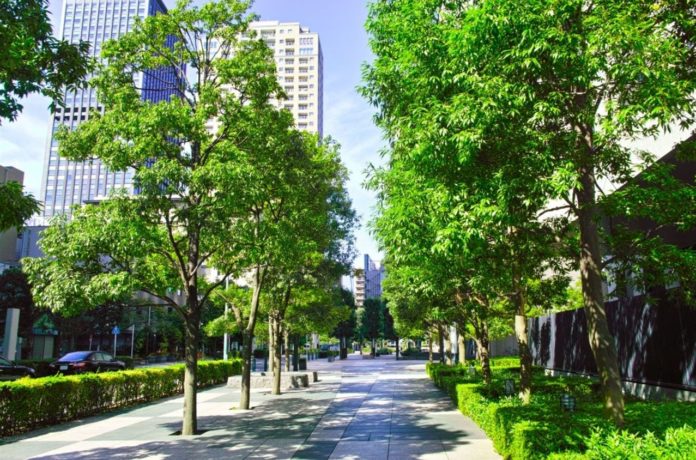New study shows how rising temperatures and artificial light in cities affect the timing of urban tree leafing.
While previous studies have examined the effect of temperature change on plants, Lin Meng’s study was the first to look at not only the effect of temperature change but the influence of artificial light, which disturbs the usual day-night cycle that plants depend on.
“The effect of light pollution on vegetation phenology is a blind spot,” says Meng, the grand prize winner of the 2021 Science & SciLifeLab Prize for Young Scientists, and a postdoctoral scholar at Lawrence Berkeley National Lab in Berkeley, California.
“We as ecologists know a lot about the impact of warming and increased carbon dioxide concentration on plants because these are the two most significant aspects of climate change… but light doesn’t change in nature…So, most people just didn’t think of it.”
During the course of her research, Meng discovered that artificial light had a significant impact on trees, an effect that is generally disregarded when designing municipal street lighting, she said.
“This research provides important insight into the impacts of the urban environment on natural processes essential to ecosystem function. Understanding how city-induced temperature and light influence vegetation both increases our knowledge of these basic ecological interactions and will help us design more resilient urban landscapes,” says Sacha Vignieri, Deputy Editor for Research at Science.
Trees face additional obstacles in urban surroundings, such as a shift in the timing of seasonal phenomena like leaf budding and greening, known as phenology. There is a phenomena known as the urban heat island effect, whereby certain areas are up to 3°Celsius hotter than the surrounding countryside because of the artificial light at night from advertising lights and buildings, public streetlights, and cars.
Human-induced changes may have an even greater impact on phenology than climate warming, Meng stated in her study. In 2015, she traveled to Beijing, China, to observe the cherry blossoms, which inspired her curiosity in exploring this option.
“The forecast showed that the peak-blossom time was 10 days early at the downtown Central Park.”
“The night before I planned to visit Central Park to see the blossoms, but snow came unexpectedly, and what I saw the next day was an almost complete loss of those emerging blossoms.”
It’s not uncommon for trees to be threatened by variables like frost or a mismatch with the timing of other creatures (e.g., pollinators) in areas with extreme temperature and leaf-greening changes.
Her observation of the cherry blossoms in Beijing prompted her to investigate how other urban environments influence tree development, which has been challenging.
“Cities exhibit higher temperatures and carbon dioxide, light pollution, and air pollution, so it’s challenging to disentangle all these effects,” Meng said.
Previous research that looked at cities’ effects on phenology were more localized and focused on the effects of urban heat islands but Meng extended it to explore the whole United States.
She analyzed spring “green-up dates” in urban vs rural areas in the 85 largest U.S. cities from 2001 to 2014 using satellite data. She discovered that spring green-up happened 6 days earlier in urban regions than in rural ones, owing to warmer city temperatures.
While urban tree greening shifted significantly earlier than rural tree greening as a result of climate change, urban tree greening responded to climate change at a slower rate than rural trees.
“Urban trees were not chilled enough in winter, so they were less responsive when days warmed up in spring,” said Meng, to explain this difference.
She also wanted to address the impact of artificial light in tree greening and leaf colour; the use of artificial light in cities has expanded dramatically in recent years, and this trend is certain to continue. Since trees require a specific amount of daylight to bud, an issue in the field has been whether tree leaves that bud earlier in the year due to warming will limit their early green-up when the day is cut short.
“Right now is the best time to tackle the question of the ecological consequences of light pollution because we have more and better satellite products of artificial light… that enable us to see daily light intensity across the globe,” Meng adds.
Meng verified in a study of trees in Europe’s Alps, an area with a generally constant temperature distribution but varying daylengths across latitudes, that shorter photoperiods – days with less light – mitigated the early spring green-up shift caused by climate change. However, in cities, the existence of artificial light extends the days in terms of available light. Meng was curious as to whether this alleviates the constraint on earlier greening found in regions such as the Alps.
Meng examined the effect of artificial light on the earlier trend in green-ups in U.S. cities by examining phenology with and without artificial light in the United States using newly released NASA Black Marble artificial light satellite data and phenology observations from the USA National Phenology Network. She discovered that artificial light accelerated the spring green-up process by nine days in regions with high levels of artificial light.
“My findings highlight artificial light as an understudied factor on phenology, which may supplement daylength and facilitate earlier spring greening under a warmer climate,” says Meng.
Meng’s future research will focus on how different vegetation species respond to different regions of the light spectrum; for example, LEDs emit a broad spectrum of light, but sodium streetlamps emit primarily in the yellow-orange region of the spectrum. Another area of study is determining the critical period of the year when trees are most vulnerable to artificial light.
“Answers to these questions will inform decision-making on what types of light we need for different locations to minimize ecological consequences,” says the author.
Source: 10.1126/science.abm8136
Image Credit:
You were reading: Warmer temperatures and artificial light in cities make tree leaves bud early
